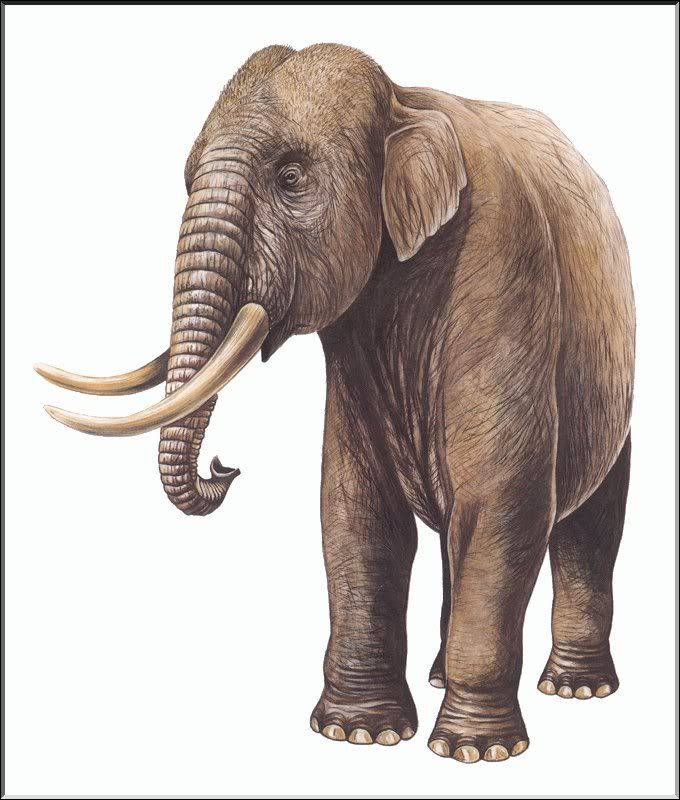|
|
Post by another specialist on Dec 22, 2007 20:40:22 GMT
|
|
|
|
Post by another specialist on Dec 22, 2007 20:40:58 GMT
On the island of Rhodes, bones of an endemic dwarf elephant have been discovered. This elephant was similar in size to Elephas mnaidriensis. Two groups of remains of dwarf elephants have been found on the island of Tilos. They are similar in size to Elephas mnaidriensis and the smaller Elephas falconeri, but the two groups indicate sexual dimorphism.[4][5] The remains had originally been designated to Palaeoloxodon antiquus falconeri (Busk, 1867). However, this name refers to the dwarf elephants from the island of Malta. As a result, since no migration route between the two islands can be proved, this name should not be used when referring to the elephant remnants from Tilos, although some scientists have accepted the temporal use of this name until further material can be examined.[4] The Tilos dwarf elephant is the first dwarf elephant whose DNA sequence has been studied. The results of this research are consistent with previous morphological reports, according to which Palaeoloxodon is more closely related to Elephas than to Loxodonta or Mammuthus. The Tilos dwarf elephant was the latest paleoloxodontine to survive in Europe. They became extinct just less than 4000 years BP, so this elephant survived well into the Holocene. en.wikipedia.org/wiki/Dwarf_elephant |
|
|
|
Post by another specialist on Dec 22, 2007 21:08:26 GMT
2. THE DWARF ELEPHANTS OF THE ISLAND OF TILOS (DODECANESE, GREECE) Available evidence, in fact, records, the existence of dwarf elephants in relatively recent times in only one Mediterranean island, the island of Tilos (Dodecanese, Greece). Located between Rhodes and Kos in the Eastern Aegean sea, at about 20 km from the nearest point of the Anatolian mainland (Bozburun peninsula), this island was inhabited by an endemic fauna which was discovered in the cave of Charkadio and included dwarf elephant remains (Fig. 1). These proboscideans have been described as belonging to the genus Elephas (Symeonidis et al. 1973, Theodorou 1983, 1988), but are still specifically unnamed (Alcover et al. 1998). They have often been compared to Elephas falconeri Busk, 1867, a taxon described from Sicily and Malta (Ambrosetti 1968). The form is, however, slightly larger than the Sicilian pygmy elephant, whilst the age of the deposits of the discovery site ranges from the very late Pleistocene to the Holocene (Theodorou 1983, 1988). Two dates were obtained through the 14C dating of the elephant bones: 7090+/- 680 and 4390 +/- 600 bp (Bachmayer & Symeonidis 1975, Bachmayer et al. 1976). These datings relate to different parts of the cave and appear to prove the simultaneous existence of the elephants and post-Palaeolithic man (Bachmayer & Symeonidis 1975, Bachmayer et al. 1976, Bachmayer et al. 1984). Furthermore, if such dating is reliable, we can presume this taxon survived at least until the beginning of the Aegean Bronze Age. www.cq.rm.cnr.it/elephants2001/pdf/402_406.pdf |
|
|
|
Post by another specialist on Dec 22, 2007 21:14:34 GMT
 Tilo Island Dwarf Elephant from my computer |
|
|
|
Post by another specialist on Dec 23, 2007 8:39:46 GMT
|
|
|
|
Post by another specialist on Dec 23, 2007 10:12:08 GMT
|
|
|
|
Post by surroundx on Apr 22, 2011 13:19:55 GMT
|
|
|
|
Post by surroundx on Oct 16, 2016 4:48:09 GMT
|
|
|
|
Post by surroundx on Oct 16, 2016 7:25:05 GMT
Theodorou, G. E. and Symeonides, N. K. (2001). The excavations of the last ten years at Charkadio cave on Tilos Island, Dodekanese, Greece, pp. 514-518. In: Cavarretta, C., Gioia, P., Mussi, M. and Palombo, M. R. (eds.). The World of Elephants – International Congress, Rome. Proceedings of the 1st international congress – Consiglio nazionale delle ricerche, Rome. [automatic download] |
|
|
|
Post by surroundx on Oct 16, 2016 13:07:58 GMT
Stathopoulou, E. T. and Theodorou, G. E. (2001). Observations on the diagenesis of dwarf elephant skeletal remains from the island of Tilos (Dodekanese, Greece), pp. 557-562. In: Cavarretta, C., Gioia, P., Mussi, M. and Palombo, M. R. (eds.). The World of Elephants – International Congress, Rome. Proceedings of the 1st international congress – Consiglio nazionale delle ricerche, Rome. [automatic download] |
|
|
|
Post by surroundx on Oct 16, 2016 14:17:40 GMT
Theodorou, G. E. and Agiadi, K. (2001). Observations on the microstructure of fossil tusks from the Charkadio cave (Tilos, Dodekanese, Greece), pp. 563-567. In: Cavarretta, C., Gioia, P., Mussi, M. and Palombo, M. R. (eds.). The World of Elephants – International Congress, Rome. Proceedings of the 1st international congress – Consiglio nazionale delle ricerche, Rome. [automatic download] |
|
|
|
Post by surroundx on Nov 27, 2017 5:26:43 GMT
Liakopoulou, D., van Heteren, A. H. and Theodorou, G. (2017). The inner morphology of petrosal bone of insular mammal: Elephas tiliensis, with the use of micro CT, pp 113. In: Book of Abstracts of the 15th Congress of the RCMNS (Regional Committee on Mediterranean Neogene Stratigraphy), entitled “Exploring a “physical laboratory”: the Mediterranean Basin”, Crown Plaza Hotel, Athens, Greece, September 3-6, 2017. |
|